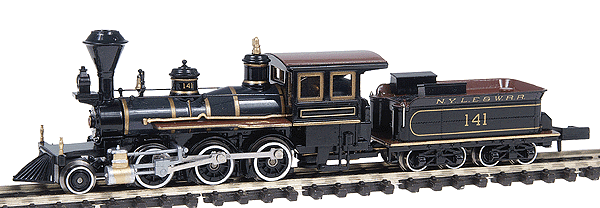

Introduced: 2004
This is quite an amazing little locomotive. It looks fantastic, and although as delivered it has some pretty serious issues in the performance department, it's at least capable of running extremely well - smooth, quiet, nimble throttle response, decent slow-speed creep, and pulling power to spare. Honestly, I hauled nine freight cars up and down the steep, winding grades of my Scenic Ridge layout with this thing and it didn't slip once. It's really quite impressive.

Unlike other similarly sized steamers, the motor in this one is actually housed inside the engine (as opposed to the tender). The motor itself is the smallest 5-poler I've ever seen. The engine chassis is all metal and split-frame. Only the rear set of drivers is geared. Apart from the brass worm, all gearing is plastic. Four of the six drivers provide pickup (the rear set of drivers being equipped with traction tires). All four wheels on the rear tender truck provide pickup as well (with current transferred to the engine chassis by way of two stiff wires on the plastic drawbar). The pilot truck and forward tender truck are electrically neutral. A working (albeit non-directional) headlight is mounted to the front of the chassis. The tender coupler is a body-mounted Rapido. There is no provision for a coupler on the pilot. Wheels are blackened and low-profile (no problems on Code-55 rails).
As alluded to above, out of the box these models do have some performance issues. The motor is very load sensitive, preventing the loco from maintaining any kind of consistant speed. Performance at slow speeds is particularly problematic, as the locomotive will want to constantly stall out (although cranking the throttle way up will usually get it moving again). The problem here is lack of lubrication, and the solution is to apply electric motor oil everywhere - the motor bearings, the axle bearings, the gears, you name it. If it moves, lubricate it. After oiling my Mogul within an inch of its life, performance improved about a thousand percent. I can now run it around in circles at very reasonable speeds, and with only the occasional hint of unevenness. Multiple applications of lubricant may be necessary, as I'm told it usually takes three or four treatments to work the lube through the system. So, mine may ultimately wind up running at "A" levels (as is, it's certainly a solid "B").
Pickup and conductivity can also be problem areas. The pickup footprint is quite small and the engine itself is very light, so spotless wheels and track are a must. Also, make sure that the stiff wires on the drawbar are clean and in firm contact with the metal posts on both the tender and engine. If loose or otherwise out of whack, you're going to lose your tender pickup.
One other problem to watch out for - the cylindars are mounted to a plastic crossmember that's screwed to the locomotive underneath the pilot truck. Said screw wasn't particularly tight on mine, allowing that crossmember a fair amount of free-play. This made the cylindars a bit crooked (one further forward than the other), and after running it around for a while the piston rod would eventually pop out of one of the cylindars, get all pointed in the wrong direction and cause the main rod to pop out of the crosshead (causing the entire mechanism to seize up). I eventually discovered that the problem was the crooked cylindars, straightened them out, tightened the screw and the problems went away.
So, lots of caveats here. But ultimately, this is a great looking model of an eye-catching prototype - and one that's just a few minor tweaks away from running every bit as good as it looks.
Prototype information -
The earliest versions of the 2-6-0 Mogul steam locomotives were built in 1863 by the Rogers Locomotive Works in Paterson, NJ. The design was an improvement on the then standard 4-4-0 wheel arrangement. In theory, the 2-6-0s extra set of driving wheels offered a 50% increase in tractive effort over the older design. It is estimated that well over 11,000 Mogul-type locos were built for the next 50-plus years. Like the 4-4-0 American-type locomotive that it was designed to replace, the 2-6-0 was a general-purpose steam locomotive that was found in both freight and passenger service. Note that the Micro Ace model is based on a Japanese prototype built in 1880 (JGR Class 7100).
To remove the engine shell, pop the press-fit top off the sand dome (the thing-ama-doohickus behind the bell). This will reveal a screw which, once removed, will allow the shell to lift right off.
Grades: C (as delivered) and B (after tuning)